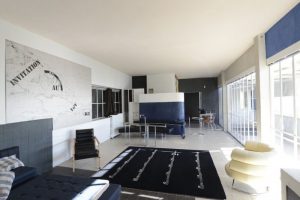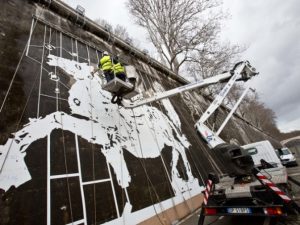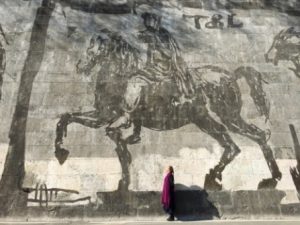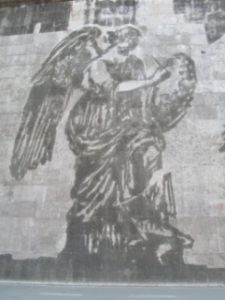Running this blog, I have been particularly fortunate this academic year in being able to persuade a number of current and former students from the department to write pieces for us. Many thanks to all of you – and I do hope these postings encourage more of you to get in touch, to share your thoughts, experiences and activities with fellow students and staff! We’ve had Gary Haines from the MPhil/PhD History of Art programme writing about his work at Crisis; Jess Stratford (BA History of Art with Curating) on the revived student History of Art society; Anna Jamieson about her time on the MA History of Art; Elizabeth Fullerton (MA History of Art 2013) on her recently published book on BritArt; Annette Waywell from the MA History of Art with Photography, with her highly successful plea for votes for Bedwyr Williams to perform at Somerset House – and, of course, a few days ago, Kathryn Hallam-Howard, BA student, on the recent field trip to Paris. For the second half of this posting, I shall hand you over to Katherine Cuthbert, who completed the BA programme here with us in 2015, and progressed straight onto the MA History of Art. She went to Rome to work on her MA Research Project, and became embroiled in a fascinating art project as a result…
But, before I pass you on for Triumphs and Laments in Rome, I want to let you know about a great opportunity for career development, and some upcoming events.
If you’re currently on our Graduate Certificate or one of our BA or MA programmes, and are thinking about how to develop your career in the Arts, or to move into this area, then I have a couple of dates for your diaries: Tuesday 21st and Tuesday 28th June. On Tuesday 21st June, 4-5.30pm, colleagues from Careers and Employability will be examining the professional routes available to history of art students, from the characteristic to the more unusual. They will also be discussing transferrable skills – where they can be drawn from, and how to use them in career development. If you would like to attend this event, please do sign up here. This session will then be followed by a careers evening organised by the department, from 6pm onwards, when a number of speakers will talk about their careers in the arts, and answer questions. There will also be drinks and nibbles – follow this link to reserve your place. Then, the following week, on Tuesday 28th June, there will be a follow up event with the Careers and Employability service, on some of the practicalities of career development. They will be talking about best practice in creating and using CVs, and about how to prepare and research for, and perform well in an interview. Here’s the link. I do strongly encourage any of you currently thinking about career development to sign up for as many of these three events as you can – they are all free, and promise to offer a wealth of useful advice and information.
So, onto other events… This Thursday, 9th June, the History and Theory of Photography Research Centre hosts its next seminar (6-7.30pm, room 112, School of Arts). Luke Gartlan, from the University of St. Andrews, and editor of the History of Photography journal, will be giving a paper entitled, ‘Before “White Australia”: The Singleton Family Photo Albums and Early Australian-Japanese Relations”. My colleagues who co-organise the Architecture, Space and Society Centre meanwhile, having put on what I’m sure is a record number of events in Arts Week, are still very busy! On Wednesday, 8th June, 6-7.30pm, Tim Benton will be speaking in the Birkbeck Cinema in the School of Arts on ‘Saving E-1027: Trials and tribulations in the re-presentation of Eileen Gray’s house by the sea’ . Tim Benton is Emeritus Professor of Art History at the Open University and will be asking: What are the issues in conserving a house whose unique value lies in the organisation of space through the use of furniture? Almost all the fixed and movable pieces of furniture by Eileen Gray were sold or stolen in the 1980s. Presenting the house empty is not an option. Professor Benton will discuss the problems facing the Association Cap Moderne, which is currently in charge of the restoration, upkeep and management of the villa.
Now for Katherine to take us to the banks of the Tiber….
Katherine Cuthbert, ‘Triumphs and Laments, a project for Rome, 2016’
“Planning a short trip to Rome to do some research on Renaissance facade painting, I discovered that William Kentridge was in the process of executing a project on the Tiber embankment wall. As this had relevance to my research project, I emailed the organization involved, requesting an interview. The artistic director agreed and, as I am an artist familiar with a variety of media, asked if I would volunteer to work with the team on the wall.
William Kentridge’s Tiber project, Triumphs and Laments, is a site specific work, 1,800 feet long and 33 feet high, executed on the only straight stretch of embankment wall of the Tiber, between the Ponte Sisto and Ponte Mazzini. The project was conceived some twenty years ago by the artist Kristin Jones, who has worked tirelessly and with great determination to bring her vision to life, despite many bureaucratic obstacles, and lack of public funding.
The frieze depicts eighty figures from antiquity to the present, in the form of a procession; themes of estrangement and transience compete with those of victory and ascendancy. Eighty figures from all of Rome’s history converse with each other across this vast space: Michelangelo’s Jeremiah, Anita Garibaldi, Partisans, migrants, Giordano Bruno, Bernini’s Ecstasy of St. Theresa, Aldo Moro, Marcus Aurelius, Pasolini, and scenes from La Dolce Vita, Trajan’s Column, and the Arch of Titus, to name a few. The frieze does not represent a chronological history of Rome: a team of art historians worked for three years gathering images from across the ages, from which Kentridge chose a selection, to present fragments from which the viewer can reconstruct a possible history that connects the ancient and the contemporary.
The imagery was executed in “reverse graffiti”. Kentridge’s small charcoal drawings were magnified, using a computer programme, and cut into huge stencils which were attached to the embankment wall. A technical crew then power washed the walls with warm water and magnesium bicarbonate, revealing the natural colour of the travertine, while the image remained in the original dirt, a combination of pollution and organic matter.
Marcus Aurelius, The Triumphs of Caesar (after Mantegna) and Winged Victory (after Trajan’s Column)
The dirt that came off the walls was carefully collected, and I worked with this rather pungent “paint” to correct the details, painting over areas where the lines had been obscured, using the original plans as guidance. Walking up and down 1,800 feet all day in the blazing sun certainly gave me all the exercise I needed! Once the wall was completed there were shadow puppets to cut out of corrugated black plastic, and costumes to make in the vast rooms of La Pelanda, Macro, Testaccio, whilst watching Kentridge rehearse processions and listening to forty musicians practising.
The work was inaugurated on 21st April with an open air opera, composed by Phillip Miller and Thuthuka Sibisi, set against the backdrop of the wall frieze, which was brightly lit with spotlights. A procession from opposite ends of the frieze -one an expression of triumphs, the other of laments – everyone carrying shadow puppets which loomed large on the wall -slowly approached each other towards the centre, while a cacophony of sounds, both weird and wonderful, projected through the night air. A evening of pure magic to celebrate the 2769th mythical anniversary of the founding of Rome, in a project brought to life with the vision of Kristin Jones, the drawings of William Kentridge and a team of volunteers.
It was a wonderful experience to work on this ethereal wall which will only last four to five years, as the biological patina gradually returns and obliterates the imagery. Not a trace now remains on the opposite wall of Kristin Jones’s She Wolves 2005.”
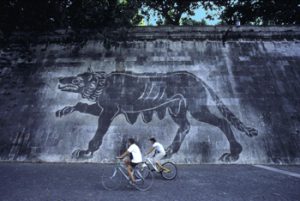 Kristin Jones, She Wolves, 2005
Kristin Jones, She Wolves, 2005
The Opera. 21st April 2016


